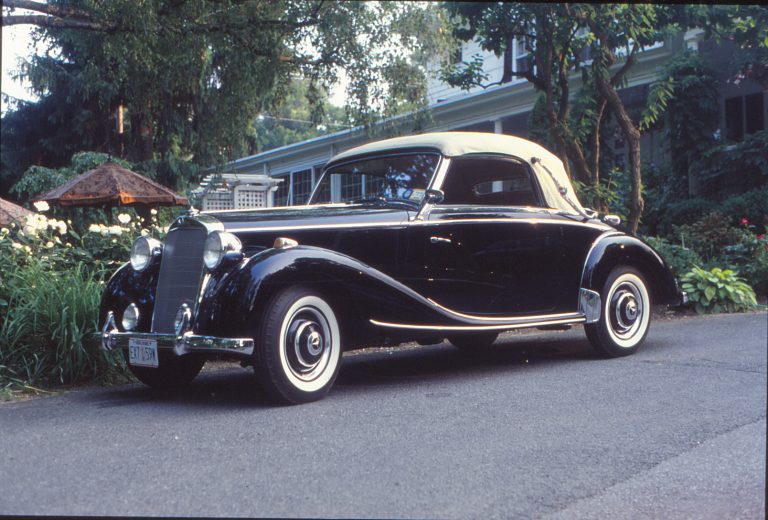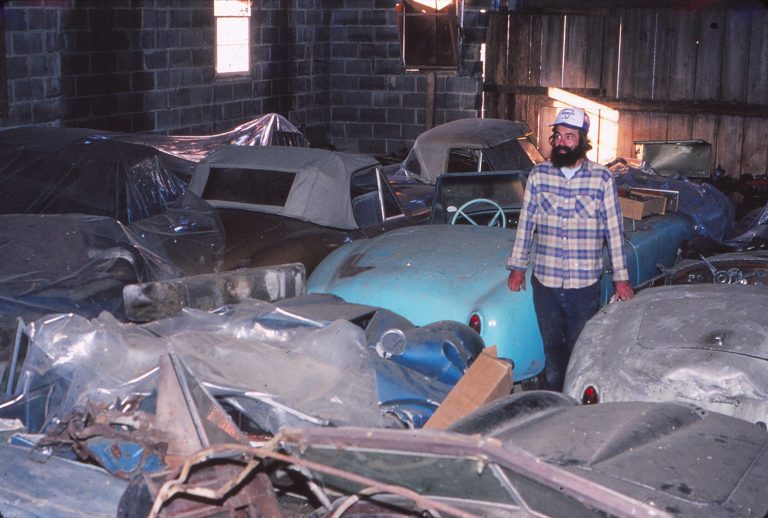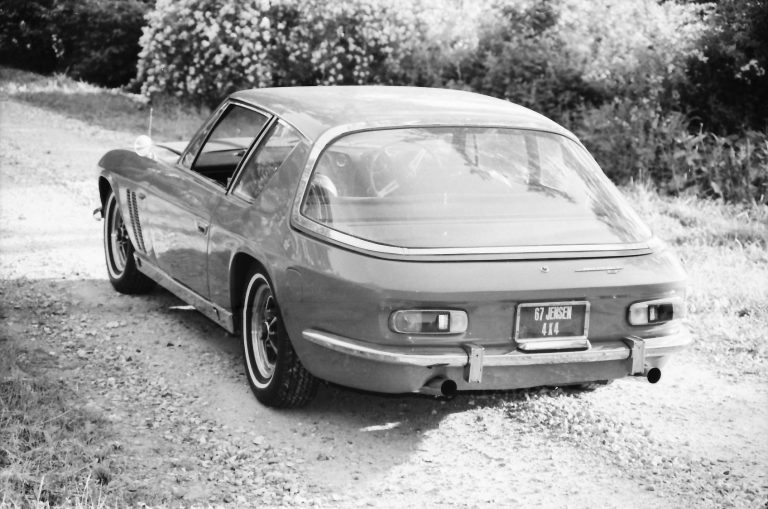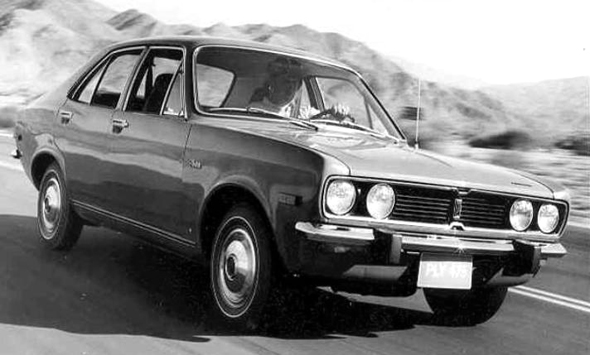Originally published in AutoWeek, November 1, 1982
1961 Jaguar Mk IX; John Matras photo.
It seems rudely out of place. There, surrounded by the Edwardian library excesses in leather and walnut, is the flat-black steering wheel. It’s a huge one-piece affair made a Bakelite-like material, with four flat spokes radiating from the hub in an intimidating X. Except for the snarling jaguar on the horn button, the wheel would look more appropriate on a riverboat in Africa than in a Jaguar Mk IX.
The Jaguar Mk IX, or mark nine, if you prefer, was the most luxurious of the Jaguar saloons of the fifties era. It was the luxury of an earlier time and a grander scale. Produced from 1959 through 1961, its styling heritage can be traced to the Mk V of the late forties and even to the pre-war 2½-liter and 3½-liter saloons. The fender line and sculptured side panels are an echo of earlier wings and running boards, and the shoulder level trim sweeping from the grille to the rear fender is a direct carryover from those first saloons.
The Mk IX, though, was a development of the Jaguar MkVII introduced in 1950. The Jaguar MkVII was to establish Jaguar firmly in the post-war luxury sporting saloon market, and that it did: Her Majesty the Queen Mother, Elizabeth, owned one.
The specifications were appropriate to the clientele. The DOHC six-cylinder XK engine, first used in the XK120 in 1948, powered the Mk VII, and torsion bar independent front suspension replaced the solid front axle of the Mk V. This combination, along with a separate frame-body and a live axle on semi-elliptics, would comprise the basic formula for the series through 1961.
The Jaguar Mk VII was surprisingly sporty. Bridesmaid finishes in 1952-1955 yielded to an outright win in the Monte Carlo rally in 1956. In sedan racing, very much in showroom stock infancy, Stirling Moss won at the International Trophy Meeting at Silverstone in 1952 and 1953, and Mike Hawthorne took the checker in 1955, all in Mk VIIs. All this was in spite of the fact that the Mk VII, as well as the Mk VIII and Mk IX to follow, weighed in at over two tons. And they were tall, with roof lines shoulder high. The much more modern Mk X debuting in 1962 was itself no lowrider, was a full 8.5-inches shorter than its predecessor.
The Mk VII was superseded in 1956 by the MkVIII, which received, among other changes, an engine uprated to match the sports cars’ and a revised body. Gone was the split windshield, a more imposing grille was fitted, and an “arabesque” trim line separated the two-tone schemes.
The Jaguar Mk VIII was replaced by 1959 by the model that was supposed to only supplement it, the Mk IX. Actually, the Jaguar Mk IX was more of an upgraded Mk VIII than an altogether new car. It was externally indistinguishable from the earlier issuance, but was equipped with superior mechanicals. Four-wheel Dunlop disc brakes replaced drum stoppers, Burman power steering was added, and the powerplant was supplanted by the engine from the 150S. This version of the twin-cam six displaced 3781cc and produced 200 horsepower at 5500 rpm.
The government of Nigeria purchased 40 of the new cats, decked out in the Nigerian colors of green and white. The father of J. Sydney King also bought one, although finished more conservatively. Syd King, community service director for WBAL-TV in Baltimore, inherited the car when his father passed on and, seeing that the car was sound but somewhat deteriorated from daily use spanning almost two decades, had the car restored by Coach Craft of Beltsville, Md. The Jaguar is gliding into its third decade in two shades of businessmen’s gray.
And indeed, it is gliding that the Jaguar Mk IX does best. This is a car for the highway. The 150S engine allows a top speed of around 115 mph, and the car is quite capable of safe and comfortable cruising at a triple digit tick.
The driver, hands on that big black wheel, has a commanding view of the road. This was the last Jaguar sedan to have a separate frame and body—the Mk X not only had the Detroit disease of that era of lower, longer, wider but was also of unit body construction—and its manner of construction as well as the style of the day contributes to what must be called a stately driving position. One drives above the common rabble of Chevies and Fords, literally as well as figuratively. Pickup drivers have the same view of traffic, but the outlook is different.
For one thing, pickup drivers don’t look down the spine of the leaping cat (it had been an option since 1937, but became standard on the Mk VIII), or over the voluptuously Rebenesque fenders and hood. Those rounded shapes are fine for the highway, but in close quarters the novice Jaguar pilot cannot be sure where the car ends. It must be a Jaguar tradition, as other cats suffered from the same affliction. They claim one becomes accustomed to it.
Another Jaguar tradition is handling, but perhaps the kindest thing that can be said about the Mk IX is that it’s no sports car. It overwhelms the winding two-lane road with its size, and although there is little lean or sway, what there is gets translated to the driver due to the distance from the pavement. It certainly doesn’t inspire toss-about driving techniques. One British writer expressed it in archetypical understatement: “Take corners carefully and extract quick acceleration on the straight.” It inspires admiration for Moss and Hawthorne that they not only raced Mk VIIs, but also won.
A surprising amount of acceleration can be extracted from the 3.8-liter, 4,000-pound car. The sports car engine coupled to a Borg-Warner transmission was capable of standing start quarter miles of less than 18 seconds. Syd King’s Mk IX, like most which reached the U.S., is equipped with the automatic (a Laycock-de Normanville overdrive was available), and the effect is peculiarly aeronautic. The RPMs and pitch of the engine rise quickly as the slack of the torque converter is taken up, then more slowly, matching acceleration. A toggle on the dash slips the automatic into its intermediate speed at less than full throttle, useful in keeping the transmission from “hunting” around town, or to move the engine up into a more comfortable RPM range for climbing long hills without stomping on the throttle.
Of course, the Mk VII through Mk IX series were never intended to be sports cars, much less racers. The big 6.50×16-inch tires were for a smooth ride more than for cornering. As for the appointments, think baroque, think rococo. Some draftsman wore out his French curve designing this one. There is a basic form which can be seen in the shape of the side windows or in the rear wheel cutouts in the fender skirts. This curve is repeated again and again, from the dash grab handle to the overall sweep of the fender line.
It’s all leather and walnut inside, with bench seats front and rear. “Bench,” though, may be a misnomer. These leather couches would be proper furnishings acceptable in a fine old English house. There is a delightful redundancy that is the sine qua non of luxury—three cigar lighters, for example. There is a clock for the rear seat passengers, though oddly not for the driver. The rear-seat passengers also have twin picnic trays that fold down from the back of the front seat. They’re made of walnut, of course.
The instruments, oil pressure and water temperature, amps and “petrol,” between a large 120-mph speedometer and 6000-rpm tachometer, are all clustered mid-dash, making placement of the steering wheel on either side of the car easier and thereby facilitating exports. Overhead there’s British air conditioning—a “sliding roof.” We call it a sun roof. So would the Brits if the sun ever shone over there.
Finally, there is that steering wheel. Perhaps it is not as inappropriate as it might seem. The Jaguar is a luxury car, but it is one intended to be driven by its owner. And in England, at least by the common mythology, privilege is accompanied by duty: The Battle of Britain, the playing fields of Eton, the Knights of the Round Table. The steering wheel, then, may be just a subconscious reminder of this heritage, a sort of automotive hair shirt. If so, then hail Britannia. There will always be a Jaguar.
© John Matras Media LLC
















